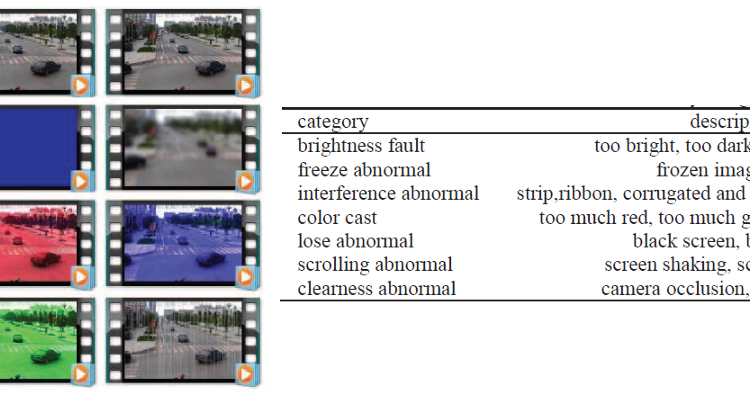
- Morphological analysis based anomaly detection has sufficiently good performance to detect five camera anomalies.
1.1. Brightness Fault (Too Bright or Too Dark)
- A brightness threshold L and a darkness threshold D are set.
- Then, all grey level of pixels in a video image is compared with L and D.
If the number of pixels with grey level great than L is greater than threshold NL, the video image is identified as too-bright-anomaly.
Similarly, if the number of pixels with grey levels less than D is greater than threshold ND, the video image is identified as too-dark-anomaly.
1.2. Brightness Fault (Gain Disorder)
- YUV color space is utilized to detect gain disorder.
- As in the figure, the greater the distance from the origin, the deeper the color is. Video image is segmented by setting deep color pixel threshold dcp.
When the number of deep pixels is greater than 1/2 of the number of all pixels, and each partition of coordinate system as shown in the figure and each image partition have uniform number of deep pixels, the current video image is an image with gain disorder.
1.3. Freeze Abnormal
When a certain number of consecutive video images are identical, freeze abnormal appears.
1.4. Lose Abnormal
- When a screen picture of a monitoring video is missing, blue or black screen presents.
Therefore, lose abnormal detection is implemented by counting the number of blue screen frames or black screen frames.
1.5. Scrolling Abnormal
- In scrolling abnormal, the content change of adjacent image frames is little, but the locations of their corresponding contents are shaking.
- If the adjacent image frames are aligned, ghosting phenomenon will occur and their contents will increase.
- First, a gradient map of current image is calculated:
- where I(x,y) is the pixel value of a pixel (x,y).
If ||fk(x,y)|-|fk+2(x,y)||>Tk, pixel (x,y) is identified as a contour point of the scrolling image region.
- For current image, the number of contour points N1 and the number of the edge points N2 are calculated.
If |N2-N1|is greater than 1/10 of the area of current image, the current image frame is identified as scrolling image.
1.6 Color Cast (too green, too blue, too red, too yellow)
- The RGB values first are transformed to the XYZ color space, and then the XYZ values are transformed to the Lab color models.
- Here, the values of Xn, Yn and Zn are 95.047, 100, and 108.883 respectively.
- After Lab values are calculated, image average chrominance D, central moment of image chrominance M.
- Color cast factor K=D/M are computed.
Then, color cast is determined according to color cast factor calculation criteria:
